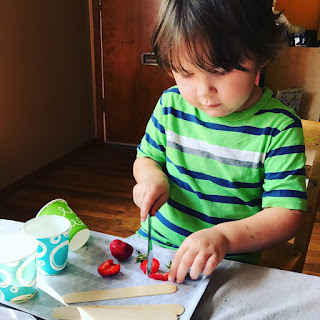At Tumbleweed, we all eat meals together - children and teachers. We discuss the food we’re eating: where it comes from, what it looks, tastes, and feels like, how it was prepared, how it makes us feel. We share stories about our families, funny things that we’ve experienced, or interesting facts we've learned. Sometimes we listen to soft music or a story on tape. Mealtime at Tumbleweed is a time of sharing nourishment, sharing stories, and sharing some special time together at the table. It’s a time to slow down from the craziness of the day and do something completely in unison...after all, one thing about people is that we all have to eat!
Often, we also include the children in preparing snacks or lunch items. If you follow our Instagram, you've likely seen photo sets of children making popsicles, granola, and pizza. We do these projects during our “small group” time so that each child involved is sure to have chances to participate in hands-on ways. Preparing food for ourselves and others to enjoy is a source of pride; it feels so good to start with a bunch of separate ingredients and end up with something recognizable and delicious. And we always feel proud to say, “I made that!” while our friends are eating and enjoying their meals.
Preparing meals puts to use so many of the skills that preschoolers naturally crave to use and practice. When I lead “cooking” small groups, I try to include some sort of simple kitchen skills and give each child a chance to practice these skills individually, while we all observe and narrate the action. We’ll each be responsible for cutting up our bananas or strawberries, for example, for the popsicles being made on our own trays. Or spreading the sauce on our English muffins for pizza, or scooping a certain amount of spice or oats or honey for our granola. These are the sorts of skills the children love to practice in their daily play as well, so they come quite naturally. This practice is how we develop hand-eye coordination and motor skills, and when presented in conjunction with preparing food, it also helps the children to visualize the processes involved in harvesting, preparing, or cooking the food they eat every day.
The first thing we do before we prepare food for our friends is to wash our hands very well, being sure to use lots of soap. Giving reminders to do this each and every time we prepare food together also presents an opportunity to discuss bacteria, germs, the spreading of illnesses, and how careful handwashing can help protect ourselves and each other.
Next, we each sit down at a tray prepared with particular ingredients and/or tools. When making popsicles, each tray is set up with paper cups and popsicle sticks; when making granola, each tray holds one or two different ingredients. Sometimes these are pre-measured, while other times they are simply laid out in their packaging and accompanied by measuring tools.
Finally, we get to the exciting part: the making! We discuss how important it is not to eat any of the food until after we’re completely finished making it, so that our germs do not get into the shared foods. Then I give step-by-step instructions. If making popsicles, I will hand out a few butter knives and guide children in cutting up their bananas or strawberries, allowing them to choose how large or small to cut them. The pieces of fruit then go in the bottoms of the cups, which gives children a chance to practice portioning and to envision the finished product along the way. After we portion out each ingredient and pop our pizzas or granola in the oven or our popsicles in the freezer, working together to very carefully carry them over to the kitchen on tray, we get to munch on the ingredients that spilled onto the tablecloth or polish off any leftover bits! This eating part makes all the work worthwhile!


It is amazing to see the joy in cooking beginning so young. Preparing meals together and then eating them together creates a conversation through activity - instead of passive consumers, the children are directly involved in the care and health of themselves and their bodies. The sense of ownership they feel over what and how they choose to consume and the background knowledge of where their food comes from is setting the stage for a healthy, positive relationship with food down the road, which we all know is such an important thing to foster in the lives of our kiddos!






Comments
Post a Comment